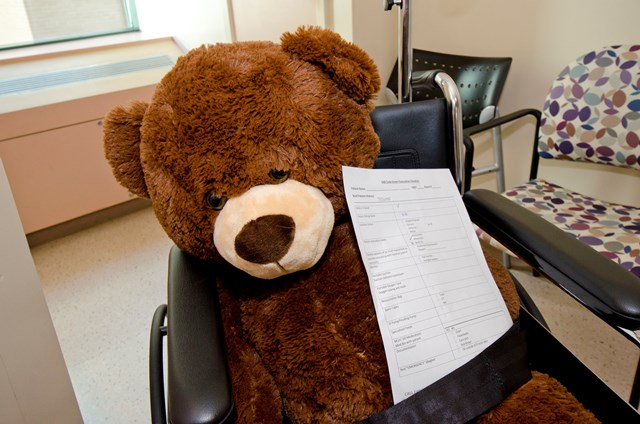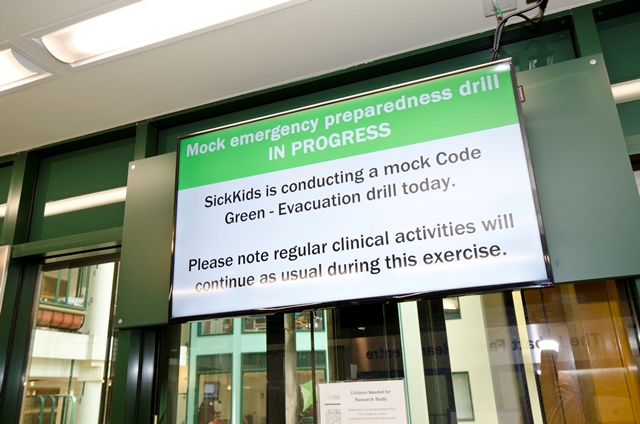Emergencies can happen quickly and without warning. No matter how much you’ve prepared, you don’t know if you’re truly ready until you’re faced with the situation.
Emergency preparedness is a top priority at The Hospital for Sick Children (SickKids), as this can have a huge impact on patient and staff safety. Over the past year, SickKids has engaged in mock drills for various emergency scenarios that can occur in hospitals. The first emergency preparedness drill was a Code Orange external disaster exercise, and the most recent was a Code Green evacuation exercise.
The recent Code Green exercise began with the fire alarm sounding on the overhead system, alerting staff of a hospital-wide drill: “Exercise, exercise, exercise. This is a Code Red.” The “virtual incident” began with a mock fire in the Microbiology Lab at 9:30 a.m. on Aug. 9. The drill tested SickKids’ response, procedures and technological needs in the event of a Code Green. In this type of emergency, the code signals an internal evacuation of patients, families, staff and visitors. A Code Green scenario could impact a clinical unit, fire zone, entire floor, multiple floors or the whole hospital.
Another announcement was made during the practice run: “Exercise, exercise, exercise. Code Green.” The escalation meant there was a need to evacuate occupants from a particular location that was, or had potential, to be dangerous.
In the Emergency Measures Command Centre, leaders representing departments from across the organization were busy coordinating the hospital-wide emergency response.
SickKids “controllers,” who wore a white ball hat and/or a yellow safety vest, enabled and guided the exercise. They provided cues during the drill, so that participants could go through actions and team processes within the Code Green drill. SickKids “observers” walked around with clipboards to note any opportunities for improvement, as participants executed their team’s specific fire and evacuation plans.
The mock drill featured a horizontal evacuation, which moves patients and occupants to a safe area on the same floor. On the overhead system, the evacuation of floors was called consecutively for logistical purposes. In a real emergency situation, an evacuation may be concurrent.
At 9:57 a.m., staff on the fifth floor unit A received evacuation instructions. All staff on the unit reported to the front desk. Cristina Franco, Registered Nurse, 5A, was the Area Leader; she performed a head count of staff and provided instructions for moving patients to the evacuation location. She referred to a tracking list, and started assigning roles to each staff member.

“Patients” – who were simulated with dolls, stuffed toys and mannequins on stretchers and wheelchairs – were moved from 5A to 5D. Before leaving the area, staff ensured all patients had proper identification bands, their medical charts, any required medical equipment and medications. Staff safely transported patients from the north to the south side of the hospital. In the exercise scenario, no patients had been injured in the evacuation process or in the fire. Real patients stayed safely in their rooms and had a front-row seat on the action. Nursing staff remained on the units to ensure that regular clinical care was not interrupted during the exercise.
Downstairs at the Operating Room Desk, staff members waited for additional instructions or announcements. When a Code Green is called, both clinical and non-clinical staff from any area of the hospital – as well as staff in other SickKids buildings – may be redeployed to help with the evacuation of patient care areas.
In the mock Code Green exercise, simulated communications asked parents not to come to the hospital during the evacuation. The Public Call Centre was set up so families and the public – played by volunteers — could contact SickKids for additional information.
SickKids held a mock media briefing to respond to the requests that were flooding in from volunteers posing as journalists. At that time 109 “patients” had been evacuated. The Code Green exercise was officially lifted at 11 a.m. All patient units from the 2nd to the 8th floors were successfully evacuated from the north to the south side of the hospital.
“Both of SickKids’ simulated emergency preparedness exercises in the past year were mornings extremely well spent,” says Dr. Michael Apkon, SickKids President and CEO. “Although they are challenging to carry out, particularly with a busy hospital, they are also critical to ensuring that we are able to react nimbly and effectively in the case of any real emergency.”


